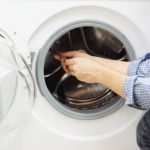Today, using an automatic washing machine is quite a common thing. But, like any technique, it sometimes fails. One of the most difficult breakdowns in a washing machine is the "development" of the oil seal and bearing and their replacement. Despite the fact that this type of repair is quite difficult, many home craftsmen can do it.
If you decide to get to the bearing and stuffing box yourself, this article is sure to come in handy.
What is an oil seal and where is it located?
Stuffing box - this is a part that serves as a seal between the two halves of the mechanism. One of these parts is fixed permanently, while the other is movable. Most often, the oil seal is made of rubber. Thus, it makes the connection not only tight, but also tight.
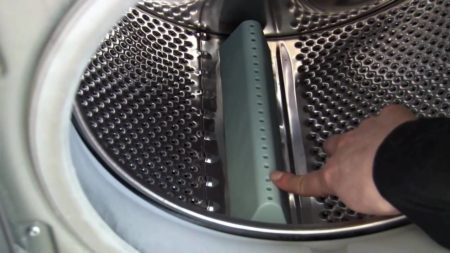
As you already understood, the oil seal is also present in the washing machine. Where is he located? For example, let's consider a “washing machine” with a front-loading type of laundry. The drum of such units is located on a special bracket, in the middle of which there is a semiaxis made of steel. A drum and a washing machine tank are attached to the axle shaft through bearings. It is in this place that you need to look for an oil seal. It is located not on the shaft itself, but on a special bronze bushing. This "couple" ensures the normal operation of the unit and protects the bearing from water. Such protection is very important, because when moisture enters the bearing, it quickly collapses and becomes covered with rust.
![]() See also - How to remove or disassemble a washing machine drum at home
See also - How to remove or disassemble a washing machine drum at home
Why the oil seal is out of order
As you already understood, the oil seal is the intermediary between the drum and the shaft on which it is fixed. When rotating, the shaft always contacts the inside of the stuffing box. From the friction that arises, the part wears out rather quickly. To prevent this from happening, the oil seal must certainly be well lubricated.
However, no matter how wonderful the lubricant is, under the influence of soapy water that seeps during washing, it is gradually washed out. The oil seal dries up and begins to pass water to the bearing, which also becomes unusable.
Stuffing box replacement
If during the rotation of the drum of the washing machine you hear a rattle and “crunch of sand”, then it's time replace bearings. The oil seal will also have to be replaced.
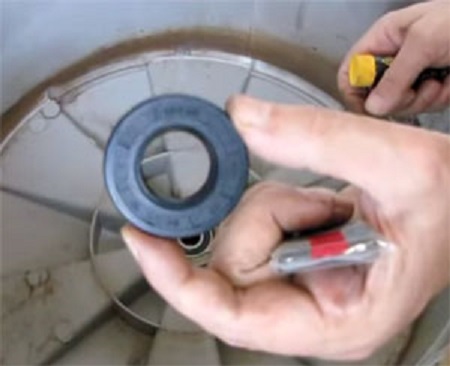
In most washing machine models, to perform such repairs, the unit will have to be disassembled almost completely.
Important:
Attention! If you are not sure that you can correctly reproduce the assembly process or are doing it for the first time, take pictures of your every step or sketch the connection diagrams.
- First you have to remove the top panel, and then remove the back and front walls of the washing machine.
- Now you need to carefully remove the counterweights (they are heavy) and disconnect the damping springs.
- Disconnect all electronic and mechanical controls carefully. Try to remember where which wire leads, so as not to get confused during assembly.
- So we got to the tank. Remove it and "split" into two halves.
- After you have done all the above steps, you can see the place where the bearings are located, and, accordingly, the oil seal.
Before replacing them, carefully inspect the cross and shaft. If the washing machine has been operating in emergency mode for a long time, chips or cracks may appear on these parts. In this case, even a new oil seal will not hold water and the repair will be useless.
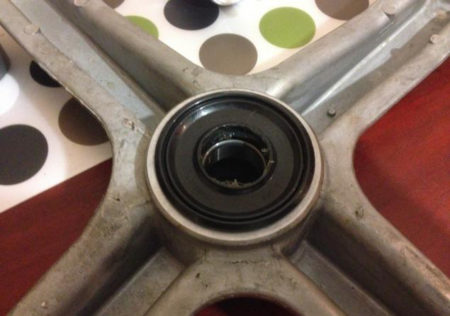
If everything is in order, remove the bearings. They just need to be knocked out with a hammer and a blunt chisel. This must be done very carefully so as not to damage the tank. Most often, the oil seal falls out along with the bearing. If this does not happen, the oil seal must be carefully removed using a flat screwdriver. Using the same screwdriver, we carefully clean the bearings. All dirt and debris from the broken part must be removed.
Before installing new bearings, the attachment points must be carefully lubricated with “Lithol” or another suitable substance.
Now all actions are performed in reverse order. We install a new oil seal and bearings, carefully pressing them in to where you took them out from. Remember to lubricate the parts thoroughly. Now you need to assemble the tank and put it in place.
How to lubricate the oil seal?
If you decide to replace the oil seal and bearings yourself, you should pay close attention to a process such as lubrication. For this, it is best to use special lubricants recommended by the manufacturer.
Grease is first applied to the outside of the gland. There is a fairly even thin layer. Then we pass to the inside. There is no need to save lubricant here, because it is in this part that the greatest friction will be observed.
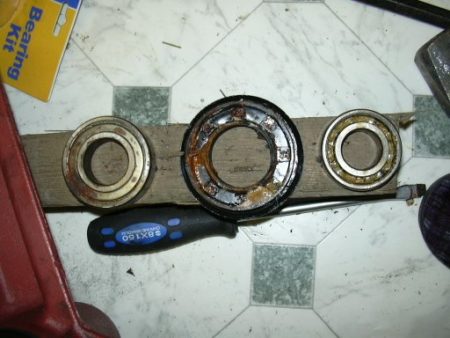
Since special grease for the oil seal can be quite expensive, many craftsmen use Solidol, Litol, Azmol and other options used in car repairs. Better not to. Although such a lubricant is an order of magnitude cheaper, the savings here are rather doubtful. The fact is that "non-core" substances soften the rubber from which the oil seal is made. As a result, it breaks down much faster and after a year or two you will have to replace it again.
Choosing the "right" lubricant
There are several criteria that can influence the selection of a good packing lubricant. To meet all the requirements, it must be:
- heat-resistant - due to friction of the shaft and stuffing box, it heats up, the lubricant must not lose its qualities with increasing temperature;
- moisture resistant - water periodically gets on the gland along with the washing powder dissolved in it;
- non-aggressive - proper lubrication should not react with the rubber from which the stuffing box is made;
- thick - the correct consistency of the substance should be such that it does not leak out during operation.
It is best to use a special silicone lubricant for the job. Titanium is also suitable. They meet all the necessary requirements. It is best to purchase them at a specialized outlet, such as where they sell spare parts for washing machines. If "silicone" is not on sale, an experienced seller will tell you how to replace it.
See also:
- Top 5 Whirlpool washing machines according to customer reviews
- 6 best Bosch washing machines according to customer reviews
- 7 best Indesit washing machines by customer reviews
- 7 best LG washing machines
- 7 best Gorenje washing machines according to customer reviews

